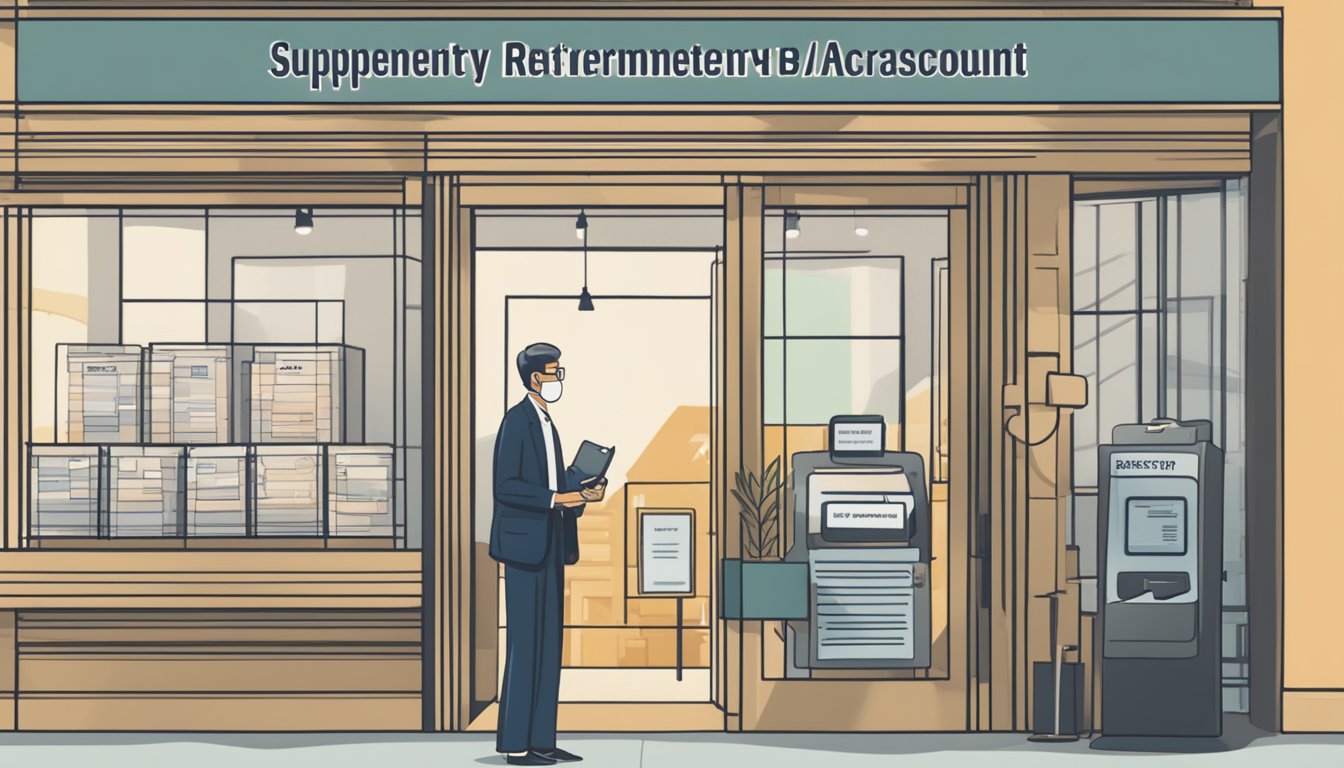Are you looking for ways to boost your retirement savings in Singapore? Then a Supplementary Retirement Scheme (SRS) account might be just what you need! This voluntary savings scheme was introduced by the Singapore government in 2001 to encourage individuals to save more for retirement, over and above their CPF savings.

One of the main advantages of the SRS account is that it provides tax relief on your contributions. According to IRAS, you can enjoy tax savings of up to $15,300 for Singaporean citizens/PRs, and $35,700 for foreigners, by contributing to your SRS account. In addition, investment returns on your SRS contributions are tax-free before withdrawal, and only 50% of the withdrawals from SRS are taxable at retirement.
The private sector operates the SRS account and complements the Central Provident Fund (CPF). It offers flexibility in terms of the amount and frequency of contributions and investment options. If you want to learn more about how an SRS account can work for you and your personal finance goals, keep reading!
1-Min Read: Quick Facts on SRS Account Showdown
Singaporean on the go? This quick guide is your key to unlocking the best SRS accounts for 2024 – all in under a minute!
SRS accounts are your secret weapon for building a rockstar retirement nest egg. They offer tax breaks and many investment options, but choosing the right one can be tricky. Here’s the lowdown on what to consider:
- Interest Rates: Get the most bang for your buck! Look for accounts with competitive interest rates to watch your savings soar.
- Fees: Beware of sneaky fees that can devour your returns. Opt for an SRS account with minimal charges.
- Contribution Freedom: Flexibility is key! Choose an account that allows easy top-ups, lump sum contributions, and hassle-free transfers.
This is just a taste of what makes an SRS account great. Dive more profound in the next section to discover advanced features, investment options, and secrets to picking the perfect account for YOU.
Get ready to unlock your dream retirement – scroll down below!
Understanding the Supplementary Retirement Scheme (SRS)

If you’re a Singaporean or a permanent resident, you should consider participating in the Supplementary Retirement Scheme (SRS) to boost your retirement savings. SRS is a voluntary scheme that allows you to save for retirement over and above your Central Provident Fund (CPF) savings. As a tax resident in Singapore, you are eligible for tax relief on your SRS contributions.
The Basics of SRS
SRS is a government-initiated scheme that began in 2001, aimed at addressing the financial needs of a greying population by helping Singaporeans save more for their old age. It complements the CPF and is operated by the private sector.
SRS contributions are entirely voluntary, and you can contribute any amount up to the SRS contribution cap. The contribution cap for Singaporeans and permanent residents is currently SGD 15,300 per year, while foreigners have a higher cap of SGD 35,700 per year.
Benefits of Participating in SRS
By contributing to SRS, you can enjoy tax relief on your contributions. The amount of tax relief you receive depends on your tax bracket, and it can be up to SGD 15,300 per year for Singaporeans and permanent residents and up to SGD 35,700 per year for foreigners.
Investment returns on your SRS contributions are tax-free before withdrawal, and only 50% of the withdrawals from SRS are taxable at retirement. This means that you can potentially save a significant amount of money on taxes by participating in SRS.
Eligibility Criteria for SRS
To be eligible for SRS, you must be a tax resident in Singapore. This means that you must have stayed or worked in Singapore for at least 183 days in a calendar year.
Singaporeans, permanent residents, and foreigners who are at least 18 years old can participate in SRS. However, foreigners must hold a valid employment pass, S pass, or work permit to be eligible for SRS.
In conclusion, the Supplementary Retirement Scheme (SRS) is an excellent way to supplement your retirement savings and reduce your tax liability. By understanding the basics of SRS, the benefits of participating in SRS, and the eligibility criteria for SRS, you can make an informed decision on whether to participate in the scheme.
Making Contributions to Your SRS Account

Saving for retirement is an important aspect of personal finance, and the Supplementary Retirement Scheme (SRS) is an excellent way to do so. Making contributions to your SRS account is easy and can provide significant tax benefits. Here’s what you need to know:
How to Contribute to SRS
You can make contributions to your SRS account in cash or through your employer. You can contribute as often as you like, subject to the maximum SRS contribution for the year. To make a contribution, you will need to have an SRS account with a participating bank or financial institution. You can open an SRS account with any of the seven participating banks in Singapore.
Contribution Limits and Tax Benefits
The SRS contribution cap is SGD 15,300 for Singapore citizens and permanent residents and SGD 35,700 for foreigners. Contributions to your SRS account are eligible for tax relief, subject to the personal income tax relief cap of SGD 80,000 per year. The amount of tax relief you can claim depends on your income level and the amount of your SRS contribution.
Making contributions to your SRS account can help you save on taxes and grow your retirement savings. You can enjoy tax savings of up to 50% of your SRS contributions. The tax savings you receive will depend on your tax bracket and the amount of your SRS contribution.
Voluntary Contributions and Their Advantages
In addition to mandatory contributions, you can also make voluntary contributions to your SRS account. Voluntary contributions can be made at any time and in any amount, subject to the yearly contribution cap. Voluntary contributions can provide several advantages, including:
- Higher tax savings: By making voluntary contributions, you can increase your tax savings and reduce your tax bill.
- Flexibility: Voluntary contributions give you more control over your retirement savings and allow you to save more when you have extra funds.
- Excess contributions: If you have excess contributions in your SRS account, you can carry them forward to offset future tax liabilities.
In conclusion, making contributions to your SRS account is an excellent way to save for retirement while enjoying significant tax benefits. Whether you make mandatory or voluntary contributions, the SRS can help you achieve your retirement goals.
Investment Opportunities within SRS

As a savvy investor, you know that the Supplementary Retirement Scheme (SRS) is a great way to save for your retirement while enjoying tax relief. But did you know that SRS also offers a wide range of investment opportunities? In this section, we’ll explore some of the best ways to invest your SRS funds to maximise your returns.
Diversifying Your SRS Investments
When it comes to investing, diversification is key. By spreading your investments across different asset classes, you can reduce your overall risk and increase your potential returns. With SRS, you have a wide range of investment instruments to choose from, including shares, bonds, unit trusts, ETFs, REITs, and more. By diversifying your SRS investments across these different investment products, you can create a well-balanced portfolio that is tailored to your risk tolerance and investment goals.
Understanding Risk and Return in SRS Investments
As with any investment, it’s important to understand the relationship between risk and return when investing your SRS funds. Generally, investments with higher potential returns also come with higher risk. It’s important to carefully consider your risk tolerance and investment goals when selecting your SRS investment products. For example, if you have a low risk tolerance, you may want to focus on lower-risk investments such as bonds and REITs. If you have a higher risk tolerance and are looking for higher potential returns, you may want to consider investing in shares and ETFs.
Popular SRS Investment Products
There are a wide range of investment products available within the SRS framework, each with its own unique features and benefits. Some popular SRS investment products include index funds, which offer low fees and broad diversification, and unit trusts, which are actively managed by professional fund managers. ETFs are also a popular choice, offering low fees and the ability to trade like shares. For those looking for a more hands-off approach to investing, robo-advisory services are also available, offering automated investment management based on your risk tolerance and investment goals.
In conclusion, SRS offers a wide range of investment opportunities to help you maximise your returns and save for your retirement. By diversifying your investments, understanding risk and return, and selecting the right investment products for your needs, you can create a well-balanced portfolio that is tailored to your unique investment goals.
Withdrawal Strategies for SRS Accounts

Are you looking for ways to make the most of your SRS account for retirement planning? Withdrawing from your SRS account can be a strategic move to maximise your retirement income. Here are some withdrawal strategies to consider:
When and How to Withdraw from SRS
You can withdraw funds from your SRS account anytime after the statutory retirement age of 63 years old. However, withdrawing earlier than that will result in a 5% penalty. To avoid penalties, you may want to wait until you reach retirement age before withdrawing from your SRS account.
When withdrawing from your SRS account, you have the option to withdraw in cash or in the form of investments. Withdrawals in the form of monies or investments from your SRS account are subject to income tax and added to your other taxable income, such as employment or rental income.
Penalties and Considerations for Early Withdrawal
If you withdraw from your SRS account before the statutory retirement age of 63 years old, you will incur a 5% penalty. This penalty applies to the amount withdrawn and is in addition to the income tax that you will have to pay on the withdrawal.
Early withdrawals from your SRS account may also impact your retirement savings and retirement needs. Withdrawing too early may mean that you have less money in your SRS account to grow and accumulate for retirement. It is important to consider your retirement needs when deciding whether to withdraw from your SRS account early.
Planning for Retirement with SRS Withdrawals
Planning for retirement with SRS withdrawals can help you maximise your retirement income. One strategy is to stagger your withdrawals over a period of time to minimise the impact of income tax. Another strategy is to plan your SRS withdrawals in conjunction with your other retirement income sources, such as CPF savings or investments, to optimise your retirement income.
By considering the penalties and considerations for early withdrawals, as well as planning for retirement with SRS withdrawals, you can make the most of your SRS account for your retirement planning needs.
Tip: Prioritize Tax Efficiency
Remember, SRS contributions enjoy tax deductions! Maximise your tax benefits by contributing the maximum allowable amount to your SRS account each year.
This reduces your current taxable income and allows your savings to grow tax-deferred.
SRS and CPF: Complementary Retirement Strategies

If you’re looking to build a solid retirement plan, you might be wondering whether to invest in the Supplementary Retirement Scheme (SRS) or the Central Provident Fund (CPF). The good news is that these two schemes complement each other, and you can use them together to maximise your retirement savings.
Comparing SRS and CPF
Both SRS and CPF are government-backed schemes that aim to help you save for retirement. However, there are some key differences between the two.
CPF is a mandatory scheme that requires you to contribute a portion of your salary every month. On the other hand, SRS is a voluntary scheme that allows you to contribute a varying amount each year, up to a cap.
One advantage of SRS is that contributions are tax-deductible. This means that you can reduce your taxable income by the amount you contribute to your SRS account. CPF contributions, on the other hand, are not tax-deductible.
Another advantage of SRS is that you have more flexibility in how you invest your savings. With CPF, your savings are invested in a government-managed fund, which may not offer the same returns as other investment options.
Integrating SRS with CPF for Maximum Benefit
While SRS and CPF are different schemes, they can work together to help you achieve your retirement goals. One way to do this is to use your SRS savings to top up your CPF Retirement Account (RA).
The CPF Retirement Account is part of the CPF Retirement Sum Scheme, which aims to provide you with a monthly payout during your retirement years. By topping up your RA with your SRS savings, you can increase your retirement income and enjoy a more comfortable retirement.
Another way to integrate SRS with CPF is to use your SRS savings to pay for your CPF Home Protection Scheme (HPS) premiums. The HPS is a mortgage-reducing insurance scheme that protects you and your family in the event of death, terminal illness or total permanent disability.
By using your SRS savings to pay for your HPS premiums, you can reduce your taxable income and enjoy greater tax savings. This can help you save more for retirement and ensure that you and your loved ones are protected in the event of unforeseen circumstances.
In conclusion, SRS and CPF are both important retirement schemes that can help you achieve your retirement goals. By using them together, you can maximise your savings and enjoy a more comfortable retirement.
Tax Considerations for SRS Account Holders

If you are considering opening an SRS account, it is important to understand the tax implications of doing so. Here are some key tax considerations for SRS account holders:
Maximising Tax Reliefs with SRS Contributions
One of the main benefits of contributing to an SRS account is the tax relief you can receive. As an SRS account holder, you can enjoy tax relief of up to $15,300 per year on your contributions. This means that you can reduce your taxable income by up to $15,300 per year, which can result in significant tax savings.
To maximise your tax relief, you should aim to contribute the maximum amount allowed each year. The SRS contribution cap is currently $15,300 per year for Singapore Citizens and Permanent Residents, and $35,700 per year for foreigners. By contributing the maximum amount, you can enjoy the full tax relief available to you.
Income Tax Implications of SRS
While SRS contributions can provide significant tax benefits, it is important to understand the income tax implications of SRS withdrawals. When you make withdrawals from your SRS account, the amount withdrawn will be subject to income tax.
However, only 50% of the amount withdrawn will be subject to income tax. This means that you can enjoy tax-free investment returns on your SRS contributions, and only pay tax on 50% of your withdrawals.
It is also important to note that SRS withdrawals are considered as part of your chargeable income. This means that if your SRS withdrawals push you into a higher tax bracket, you may end up paying more income tax overall.
Other Tax Benefits of SRS
In addition to the tax relief and tax-free investment returns, there are other tax benefits of holding an SRS account. For example, SRS contributions can help to reduce your chargeable income, which can result in lower income tax.
SRS withdrawals can also be timed strategically to minimise your income tax liability. For example, if you plan to retire in a year where you expect to have a lower income, you can time your SRS withdrawals to take advantage of the lower tax bracket.
Overall, an SRS account can provide significant tax benefits for those looking to save for retirement. By understanding the tax implications of SRS contributions and withdrawals, you can make informed decisions about how best to use your SRS account to maximise your tax savings.
Additional Resources for SRS Account Management

If you’re looking for more information on managing your SRS account, there are a variety of resources available to help you navigate the process. Here are a few suggestions to get you started:
Navigating the SRS with Financial Institutions
Many financial institutions in Singapore offer SRS accounts, including DBS and POSB. These accounts allow you to contribute to your SRS and invest your funds in a range of SRS-approved products. You can also use these accounts to track your contributions and withdrawals, making it easier to manage your SRS account over time.
When choosing an SRS account provider, it’s important to consider factors such as fees, investment options, and customer support. Look for a provider that offers low fees and a wide range of investment options, so you can tailor your SRS portfolio to your specific financial goals. You may also want to consider working with a financial advisor who can help you make informed decisions about your SRS investments.
Government Policies and Future Prospects of SRS
The Singapore government has introduced a range of policies to encourage SRS savings, including tax incentives and the introduction of new SRS-approved investment products such as the Singapore Savings Bond and Singapore Government Securities. These policies are designed to help Singaporeans save for retirement and build a more secure financial future.
Looking ahead, the Ministry of Finance has indicated that it will continue to support SRS savings and explore new ways to encourage Singaporeans to save for retirement. This could include the introduction of new tax incentives or investment products, so it’s important to stay up-to-date on the latest developments in SRS policy.
Conclusion
By taking advantage of these resources, you can make the most of your SRS account and build a more secure financial future. Whether you’re just getting started with SRS savings or you’re looking to optimize your existing SRS portfolio, there are a range of tools and resources available to help you achieve your goals.
Frequently Asked Questions
What are the benefits of opening an SRS account in Singapore?
Opening an SRS account in Singapore can provide you with several benefits. Firstly, it allows you to save for your retirement while enjoying tax relief. Secondly, the investment returns on your SRS account are tax-free before withdrawal. Lastly, you can withdraw your SRS funds at any time, although there are tax implications to consider.
How can I withdraw funds from my SRS account and what are the implications?
You can withdraw your SRS funds anytime, but there are tax implications to consider. All withdrawals from your SRS account are generally taxable. If you withdraw your SRS funds before the statutory retirement age, you will be subject to a penalty of 5% on the amount withdrawn.
However, if you withdraw your SRS funds after the statutory retirement age, only 50% of the withdrawals will be taxable.
What is the current interest rate offered on SRS accounts in Singapore?
The interest rate offered on SRS accounts in Singapore varies depending on the bank or financial institution you choose. Generally, the interest rate is lower than other savings accounts, as SRS accounts are intended for long-term retirement savings rather than short-term savings.
Is there a minimum balance required to maintain an SRS account?
Yes, a minimum balance is required to maintain an SRS account. The minimum balance varies depending on the bank or financial institution you choose. However, the minimum balance is typically around $1,000.
Can expatriates or foreigners open an SRS account in Singapore?
Yes, expatriates or foreigners can open an SRS account in Singapore. However, they must meet certain eligibility criteria, such as being at least 18 years old and not an undischarged bankrupt. They must also not have an existing or pending SRS account or account application with any bank.
Are there any limitations or downsides to having an SRS account?
There are some limitations and downsides to having an SRS account. Firstly, there is a cap on the amount you can contribute to your SRS account each year. Secondly, there are penalties for early withdrawals. Lastly, while SRS accounts offer tax benefits, they may not be the best option for everyone, depending on your financial situation and retirement goals.
Fast, Fair, and Hassle-Free Loans with Quick Credit
Need a personal loan to cover unexpected expenses or finally reach your financial goals? Quick Credit Pte Ltd is here to help! We’re a licensed and reliable money lender in Singapore, offering fast and transparent personal loans to get you back on track.
Why Choose Quick Credit?
- Trustworthy & Reliable: We’re a fully licensed moneylender with a proven track record of exceptional service.
- Competitive Rates: We offer some of the best personal loan rates in Singapore, so you can be sure you’re getting a fair deal.
- Fast & Easy Application: Apply online or visit us in Jurong for a quick and hassle-free application process.
- Transparent Terms: We clearly explain all loan terms and fees upfront, with no hidden costs.
- Accessible to All: We serve borrowers all over Singapore, helping you get the financial support you need.
